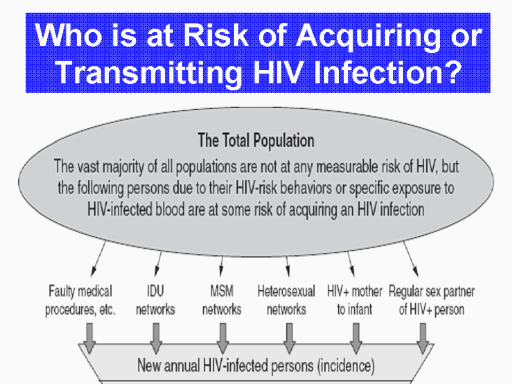| front |1 |2 |3 |4 |5 |6 |7 |8 |9 |10 |11 |12 |13 |14 |15 |16 |17 |18 |19 |20 |21 |22 |23 |24 |25 |26 |27 |28 |29 |30 |31 |32 |33 |review |
 |
HIV is
transmitted from person to person primarily via blood and sexual
fluids such as semen and any other body fluid that may contain
blood. The probability of HIV transmission for any single exposure
is directly related to the amount of infected blood or semen
exchanged. This risk ranges from a low of <1 per 1,000 coital acts
from an infected female to her male sex partner, up to 90% or more
from receiving a transfusion of infected blood.
The vast majority of persons in any “general” population are
not at any measurable risk of contracting an HIV infection.
However, persons or groups shown in the figure may be at
varying risk of HIV infection.
The
patterns and prevalence of these modes of HIV transmission differ
between different countries and regions.
For example in sub-Saharan African countries, heterosexual transmission predominates and the numbers of mother to infant transmission and transmission within healthcare settings are the highest in the world. In most developed countries, HIV transmission within MSM and IDU networks predominate and transmission within healthcare settings is rare. However, transmission from an HIV-infected person to his/her regular sex partner is probably, as of mid-2007, the predominant mode of HIV transmission in most populations throughout the world. These differences in the patterns and prevalence of these modes of transmission should not be interpreted to imply that specific programs directed to each mode of transmission are not needed in all regions and countries. MSM and IDU networks should be considered to be present in all regions and countries. |